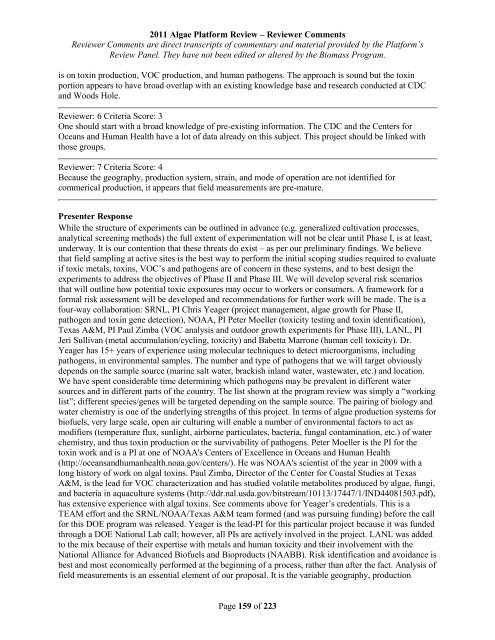Reviewer Comments - EERE
Reviewer Comments - EERE
Reviewer Comments - EERE
You also want an ePaper? Increase the reach of your titles
YUMPU automatically turns print PDFs into web optimized ePapers that Google loves.
2011 Algae Platform Review – <strong>Reviewer</strong> <strong>Comments</strong><br />
<strong>Reviewer</strong> <strong>Comments</strong> are direct transcripts of commentary and material provided by the Platform’s<br />
Review Panel. They have not been edited or altered by the Biomass Program.<br />
is on toxin production, VOC production, and human pathogens. The approach is sound but the toxin<br />
portion appears to have broad overlap with an existing knowledge base and research conducted at CDC<br />
and Woods Hole.<br />
<strong>Reviewer</strong>: 6 Criteria Score: 3<br />
One should start with a broad knowledge of pre-existing information. The CDC and the Centers for<br />
Oceans and Human Health have a lot of data already on this subject. This project should be linked with<br />
those groups.<br />
<strong>Reviewer</strong>: 7 Criteria Score: 4<br />
Because the geography, production system, strain, and mode of operation are not identified for<br />
commerical production, it appears that field measurements are pre-mature.<br />
Presenter Response<br />
While the structure of experiments can be outlined in advance (e.g. generalized cultivation processes,<br />
analytical screening methods) the full extent of experimentation will not be clear until Phase I, is at least,<br />
underway. It is our contention that these threats do exist – as per our preliminary findings. We believe<br />
that field sampling at active sites is the best way to perform the initial scoping studies required to evaluate<br />
if toxic metals, toxins, VOC’s and pathogens are of concern in these systems, and to best design the<br />
experiments to address the objectives of Phase II and Phase III. We will develop several risk scenarios<br />
that will outline how potential toxic exposures may occur to workers or consumers. A framework for a<br />
formal risk assessment will be developed and recommendations for further work will be made. The is a<br />
four-way collaboration: SRNL, PI Chris Yeager (project management, algae growth for Phase II,<br />
pathogen and toxin gene detection), NOAA, PI Peter Moeller (toxicity testing and toxin identification),<br />
Texas A&M, PI Paul Zimba (VOC analysis and outdoor growth experiments for Phase III), LANL, PI<br />
Jeri Sullivan (metal accumulation/cycling, toxicity) and Babetta Marrone (human cell toxicity). Dr.<br />
Yeager has 15+ years of experience using molecular techniques to detect microorganisms, including<br />
pathogens, in environmental samples. The number and type of pathogens that we will target obviously<br />
depends on the sample source (marine salt water, brackish inland water, wastewater, etc.) and location.<br />
We have spent considerable time determining which pathogens may be prevalent in different water<br />
sources and in different parts of the country. The list shown at the program review was simply a “working<br />
list”; different species/genes will be targeted depending on the sample source. The pairing of biology and<br />
water chemistry is one of the underlying strengths of this project. In terms of algae production systems for<br />
biofuels, very large scale, open air culturing will enable a number of environmental factors to act as<br />
modifiers (temperature flux, sunlight, airborne particulates, bacteria, fungal contamination, etc.) of water<br />
chemistry, and thus toxin production or the survivability of pathogens. Peter Moeller is the PI for the<br />
toxin work and is a PI at one of NOAA's Centers of Excellence in Oceans and Human Health<br />
(http://oceansandhumanhealth.noaa.gov/centers/). He was NOAA's scientist of the year in 2009 with a<br />
long history of work on algal toxins. Paul Zimba, Director of the Center for Coastal Studies at Texas<br />
A&M, is the lead for VOC characterization and has studied volatile metabolites produced by algae, fungi,<br />
and bacteria in aquaculture systems (http://ddr.nal.usda.gov/bitstream/10113/17447/1/IND44081503.pdf),<br />
has extensive experience with algal toxins. See comments above for Yeager’s credentials. This is a<br />
TEAM effort and the SRNL/NOAA/Texas A&M team formed (and was pursuing funding) before the call<br />
for this DOE program was released. Yeager is the lead-PI for this particular project because it was funded<br />
through a DOE National Lab call; however, all PIs are actively involved in the project. LANL was added<br />
to the mix because of their expertise with metals and human toxicity and their involvement with the<br />
National Alliance for Advanced Biofuels and Bioproducts (NAABB). Risk identification and avoidance is<br />
best and most economically performed at the beginning of a process, rather than after the fact. Analysis of<br />
field measurements is an essential element of our proposal. It is the variable geography, production<br />
Page 159 of 223




